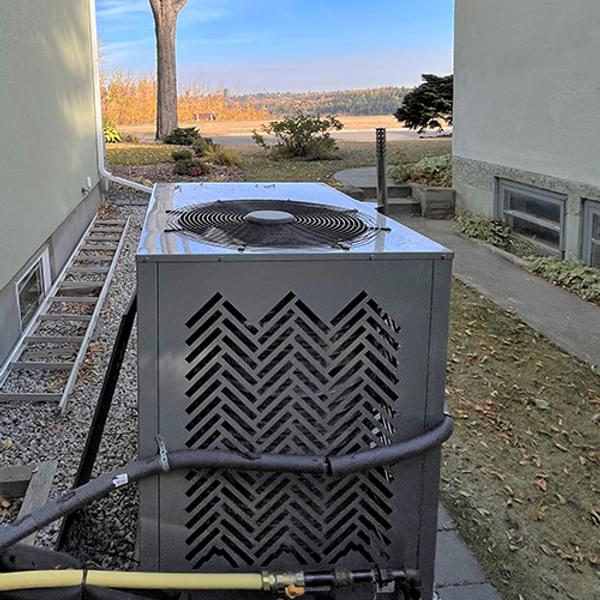Gas Heat Pump Technology: Your Questions Answered, Part 2
- Written by Nicole Karpavich
- October 28, 2024

Welcome to Part 2 of our exploration into gas heat pumps and their role in shaping the future of energy solutions. In our previous discussion, we covered the technology’s impressive efficiency and its advantages in cold climates. Now, we’ll shift focus to the challenges gas heat pumps face in market adoption, cost comparisons, and the broader conversation around decarbonization. Join us as Scott Reed, VP Sales & Marketing at SMTI, shares insights on how the industry is overcoming these obstacles and paving the way for a more sustainable future.
NK: We’ve discussed many benefits, so let’s move to challenges. What are some of the challenges GHPs have been facing in the market?
A. Firstly, that no one knows that we exist! A specific example is in Illinois, where a regulatory panel was considering whether to include GHPs in the Illinois Building Stretch Code. Alongside Nicor Gas, People’s Gas, and the North American Gas Heat Pump Collaborative, we testified to educate the panel about GHP benefits and highlighted that there are products available in the market today. Their final decision was to include GHPs in the Stretch Code, which has created momentum for the product in Illinois, which is very exciting. However, we still have a lot of work to do across the U.S. and Canada. Getting the word out will be an ongoing effort for many years to come.
Secondly, the current conversation about how to decarbonize cold-climate heating, in some quarters, seems to reject gas and the pipeline network as having anything to contribute to the ultimate solution. But GHPs offer, in most jurisdictions, the lowest cost of delivered heat, plus the lowest green-house-gas footprint compared to either traditional gas heating appliances, or electric heat pumps depending on grid mix. This is not yet widely understood. What we mainly have to do is get these products out on the market and show the data for the world to see. And it’s not just us – there are other GHP manufacturers that are in or about to be in the market. We all need to succeed in order to build the category.
NK: Are costs also a barrier?
A. It depends on what you compare us to, and it’s important to differentiate between installation costs and operating costs.

As I said earlier, we start by saving the home or building owner 30-50% off their heating bills compared to traditional gas heating appliances, especially in cold climates, thanks to our 140% AFUE rating. Additionally, we are much less costly than EHPs to deliver heat, particularly in cold climates. In fact, in these climates, EHPs usually raise, not lower, a homeowner’s cost of heat if they’re being converted over from gas.
Regarding installation costs, if you compare us to traditional gas furnaces, GHPs are somewhat more expensive, but so are EHPs. However, the days of gas furnaces and boilers are numbered – it’s just a matter of when, which people can debate about. So, if this is the beginning of a new “Era of Heat Pumps”, it’s logical to compare our installation costs against EHPs. In the very broadest terms, we’re roughly in the same ballpark for installation costs; but often, we’ll be less expensive because we don’t burden homeowners with ductwork or electrical panel upgrades, which can easily add thousands of dollars to the project.
When considering lifecycle costs, if you factor in a product’s lifespan of 15 to 20 years along with operating cost savings over that time, the advantage almost always will go to the GHP. This is especially true because, in most regions, gas is cheaper than electricity
For retrofit projects, which make up about 90% of the market, we’re competitive. Homes built for gas heating typically have ductwork sized for gas, and we designed our product to be plug-and-play. Our installations can usually be completed in a day or two, and GHPs typically don’t require an electrical panel upgrade, which can be costly. In contrast, EHPs sometimes require new ductwork and electrical panel upgrades.
The other issue homeowners will consider is comfort, which isn’t economic per se, but it drives decisions just as much and often more than pure economics. If you’re used to a toasty warm blast of air coming from your forced-air registers when it’s cold outside and the furnace comes on, you won’t be disappointed with a GHP. By contrast, the heating experience of EHPs is very different, and contractors are explicitly taught to change their customer’s expectations about the way they experience the product. EHPs can’t and don’t blast warm air, which may be disappointing for some people.
NK: You mentioned that people don’t know that GHPs exist. How are you overcoming that challenge?
A. Education – education – education! For 90% of homeowners, they don't care what their actual heating technology is. While heat pumps are becoming more widely available, homeowners primarily care about two things: delivering strong comfort and achieving low utility bills, especially in cold climates. Our messaging focuses on highlighting how this heat pump can provide the lowest winter heating costs. This approach aligns with our market research, which found that, on the economic front, homeowners’ technology choices are primarily driven by operating costs than installation costs. This may seem counterintuitive to some, but we’ve seen this result in two separate national studies, and the difference is significant.
NK: How are you including contractors? They are probably going to be the ones selling them to the end users.
A. Yes, contractor training is very important. That’s why we’ve developed a program called Anesi University.

This training program includes various levels, covering everything from heat pump basics to installation, servicing and repair. If you visit our website, you’ll find a growing list of online training resources. We’re also actively training contractors through our manufacturer representatives, who are key to localized support. Their job is to ensure contractors have the knowledge and skills needed to effectively sell and service our products.
NK: Carbon emissions are also an interesting piece of this. Can you explain a bit more?
It’s a very complex issue because the amount of carbon on the electric grid varies hour by hour, day by day, and season by season. When the grid has a relatively high GHG impact—during periods of low solar and wind generation, such as at night or in winter— that’s when gas becomes most needed. Utilities generally, and for the foreseeable future, will use natural gas generation to “firm-up” the grid, and the generators that do this are some of the highest carbon-emitting facilities that exist.
In cool and cold climates, GHPs are the lowest carbon-emitting heating technologies available. If our product can help save money, offer high efficiency, and help decarbonize while stabilizing the grid, then it makes sense to keep gas heating products on the table. Gas isn’t going away any time soon; and this is about preserving a range of responsible choices for consumers and allowing them to choose what works best for their individual situations. Plus, the whole gas system is just at the beginning stages of transitioning away from traditional ground-sourced methane and towards low or zero-net carbon gases. Gas molecules are much more efficient energy-carriers for the extremely intensive loads involved for winter-heating, compared to the relatively light energy density inherent to electricity. So, it makes economic sense to maintain our already-paid-for gas network, while transitioning the molecules being delivered over to a resource that’s every bit as clean and renewable as wind or solar power. Both energy systems are needed and optimized for different uses, and I believe the energy transition now underway will go faster and be more economically sound if we avoid taking options off the table and innovate instead. That’s what Anesi Gas Heat Pumps and others are trying to do.
As we’ve explored, gas heat pumps offer a compelling solution for efficient, low-carbon heating, but challenges like market awareness and cost perceptions remain. This concludes our deep dive into gas heat pumps, but the conversation around their role in a more sustainable energy future is just beginning. Keep an eye out for future updates as this technology continues to evolve and make its mark on the energy landscape.
Related Energy Resources
Explore our decarbonization solutions.